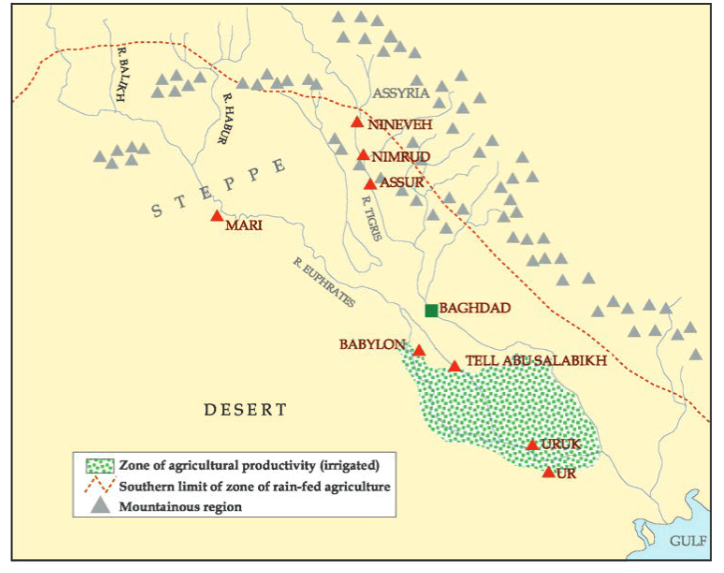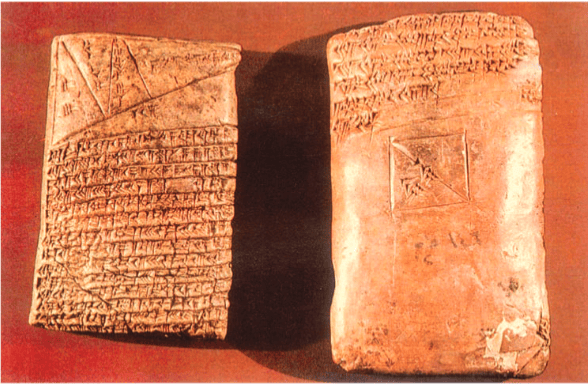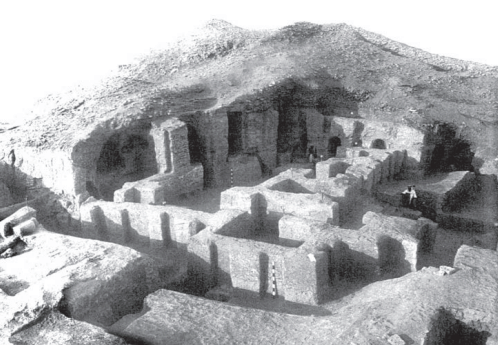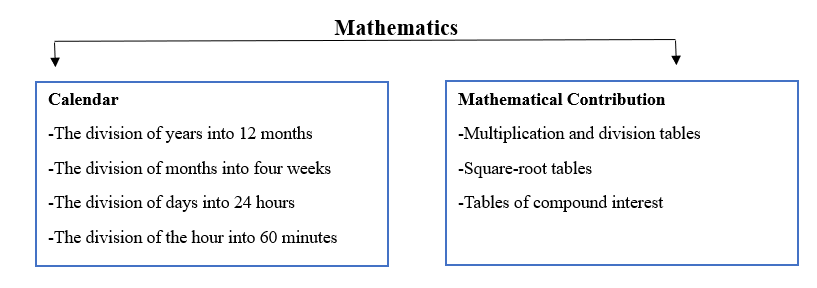Writing and City Life Chapter Notes | History Class 11 - Humanities/Arts PDF Download
Introduction
City life began in Mesopotamia, the land between the Euphrates and Tigris rivers, now part of the Republic of Iraq. Mesopotamia comes from two Greek words: mesos, meaning middle, and Potamos, meaning river.

- Mesopotamia's writing system and literature spread to the eastern Mediterranean, northern Syria, and Turkey after 2000 BCE, allowing kingdoms in the region to communicate with each other and with the Pharaoh of Egypt in Mesopotamian language and script.
- Early on, the urbanized south of Mesopotamia was called Sumer and Akkad. After 2000 BCE, as Babylon rose in importance, the southern region became known as Babylonia.
- By around 1100 BCE, with the rise of the Assyrian kingdom in the north, the area became known as Assyria.
- Historians use various sources to study the city life in Mesopotamia:

Languages

Sumerian (Before 2400 BCE): The earliest known language of the region.
Akkadian (Around 2400 BCE): Began to replace Sumerian when Akkadian speakers arrived. Akkadian thrived until the time of Alexander the Great (336-323 BCE), with some regional variations.
Aramaic (From 1400 BCE): Aramaic, a language similar to Hebrew, started to spread and became widely spoken after 1000 BCE. It is still spoken in some parts of Iraq today.
Mesopotamia and Its Geography
 Map: Mesopotamia
Map: Mesopotamia
North-East: Green plains and mountains with streams and wildflowers; suitable for agriculture, which began between 7000-6000 BCE.
North: A steppe region ideal for animal herding; sheep and goats graze on grasses after winter rains.
East: Tigris tributaries offer routes to the Iranian mountains.
South: A desert where the first cities and writing emerged. The Euphrates and Tigris rivers deposit fertile silt, supporting agriculture through natural and man-made irrigation channels.
Agriculture: Despite low rainfall, southern Mesopotamia’s agriculture was highly productive. Wheat, barley, peas, and lentils thrived.
Livestock and Resources: Sheep and goats in highlands produced meat, milk, and wool. Fish from rivers and dates from palm trees added to the food supply.
City Growth: Cities didn't grow solely from rural prosperity; other factors contributed, which will be explored further.
The Significance of Urbanism
Beyond Population: Cities and towns aren't just large populations; they thrive when the economy diversifies beyond food production to include trade, manufacturing, and services.
Interdependence: City residents rely on each other’s products and services. For example, a stone seal carver needs bronze tools and colored stones but doesn't make or source these himself. Similarly, a bronze tool maker depends on others for metals and charcoal.
Division of Labour: This specialization and division of labour are key features of urban life, making people dependent on one another.
Social Organisation: Efficient urban functioning requires organised trade and storage systems. Resources like fuel, metal, and wood come from various locations, while grain and other food supplies are transported from villages to cities.
Coordination and Management: Different activities must be coordinated, and resources need to be readily available. Urban economies often necessitate hierarchical structures for managing operations and rely on written records for administration.
Movement of Goods into Cities
Resource Scarcity: Mesopotamia had rich food resources but lacked mineral resources. The south was short on stones for tools and jewels, quality wood for carts and boats, and metal for tools and ornaments.
Trade: To compensate, Mesopotamians likely traded their textiles and agricultural produce for wood, copper, tin, silver, gold, shell, and stones from regions like Turkey, Iran, or across the Gulf. These areas had minerals but less capacity for agriculture.
Social Organisation: Efficient trade required social organisation to manage foreign expeditions and coordinate exchanges.
Transport: Efficient transport was crucial for urban growth. Land transport of goods like grain or charcoal via animals was slow and costly due to feed requirements. The cheapest transport was over water using river boats or barges, which utilized currents and wind.
Canals and Rivers: Canals and natural channels in Mesopotamia served as major routes for transporting goods between settlements, with the Euphrates playing a key role as a "world route."
The Development of Writing
Verbal Communication: All societies use verbal communication to convey meanings through spoken sounds. Writing is another form of verbal communication, where spoken sounds are represented by visible signs.
Origins of Writing: The first Mesopotamian tablets date back to around 3200 BCE and featured picture-like signs and numbers. These early writings, found in the city of Uruk, were lists of goods such as oxen, fish, and bread loaves, primarily used to keep records of transactions in temples.
Need for Record Keeping: Writing emerged due to the need to record transactions in city life, which involved multiple people, times, and goods.
Writing Method: Mesopotamians wrote on clay tablets. A scribe would wet and smoothen the clay, then use a reed to press wedge-shaped signs (known as cuneiform) onto the surface. Once dried, these tablets became as durable as pottery and were often discarded once records were no longer needed. This led to the abundance of tablets found at Mesopotamian sites, providing extensive knowledge about the civilization.
 A clay tablet written on both sides in Cuneiform
A clay tablet written on both sides in Cuneiform
Evolution of Writing: By 2600 BCE, writing evolved into cuneiform in the Sumerian language, expanding beyond record-keeping to include dictionaries, legal documents, royal deeds, and laws.
Language Shift: Sumerian was gradually replaced by Akkadian after 2400 BCE, but cuneiform writing in Akkadian continued until the first century CE, spanning over 2,000 years.
The System of Writing
Syllabic Signs: Unlike the English alphabet, where each sign represents a single consonant or vowel (like "m" or "a"), a cuneiform sign represented a syllable (such as "say," "put," "la," or "in").
Complexity: This meant Mesopotamian scribes had to learn hundreds of signs. They also needed the skill to write quickly on a wet clay tablet before it dried.
Skilled Craft: Writing in cuneiform was a skilled craft and a significant intellectual achievement, as it visually represented the complex system of sounds in the language.
Literacy
Limited Literacy: Very few Mesopotamians were literate because learning to read and write required mastering hundreds of complex signs.
Status Symbol: Literacy was rare, and if a king could read, it was often highlighted in his inscriptions as a point of pride.
Oral Reflection: Writing closely mirrored spoken language. For instance, letters from officials to the king would be read aloud and typically started with:
"To my lord A, speak: … Thus says your servant B: … I have carried out the work assigned to me …"
The Uses of Writing
- Epic Poem: A long Sumerian epic about Enmerkar, an early ruler of Uruk (the prominent city), illustrates the connection between city life, trade, and writing.
Journey and Challenges: The messenger traveled through mountain ranges and faced difficulties. He struggled to convince the chief of Aratta to trade and made several trips back and forth, carrying the king's messages.
Introduction of Writing: When the messenger became overwhelmed and confused, Enmerkar decided to use a clay tablet to record his messages. This marked a significant moment as writing was then introduced as a means to store information and communicate.
Significance of Writing: The ruler of Aratta examined the tablet, viewing the written words as crucial. This story highlights that kingship organized trade and writing and underscores that writing was a symbol of Mesopotamian urban superiority.
Urbanisation in Southern Mesopotamia: Temples and Kings
Early Settlements: By 5000 BCE, settlements began to form in southern Mesopotamia, leading to the emergence of cities.
Types of Cities:
1. Temple Cities: Developed around temples, which started as small shrines and grew larger with multiple rooms and courtyards. Temples were seen as the homes of gods and were central to community life.
2. Trade Cities: Developed as centers for trade.
3. Imperial Cities

Role of Temples:
1. Religious Focus: Temples housed gods and were centers of worship, receiving offerings like grain and fish.
2. Economic Role: Temples organized production (e.g., oil pressing, grain grinding), employed merchants, and kept written records of goods.
 A temple with an open courtyard
A temple with an open courtyard
Agricultural Challenges:
1. Flooding and Water Management: The Euphrates' natural channels could cause flooding or shift course, and conflicts over water and land were common.
2. Villages Relocation: Archaeological evidence shows that villages were often relocated due to these issues.Role of War Leaders:
1. Conflict and Power: War leaders who succeeded in battle could enhance their influence by redistributing loot and employing prisoners.
2. Temple Contributions: Successful leaders beautified temples and organized temple wealth, boosting their status and authority.Urban Growth:
1. Uruk: One of the earliest temple towns, grew significantly by 3000 BCE, expanding to 250 hectares. It had a defensive wall and saw a major population shift from smaller villages.
2. Construction and Workforce: Large-scale projects like temples required thousands of workers, often including war captives. Workers were compensated with rations.Technological Advances:
1. Bronze Tools: Introduced for crafting.
2. Architectural Innovations: Brick columns and complex constructions without suitable wood.
3. Art and Craft: Use of imported stone for sculptures and clay cones for colorful mosaics.
4. Potter’s Wheel: Enabled mass production of similar pots, marking a significant technological advancement in urban economies.
Life in the City
Ruling Elite: A small elite class in Mesopotamia accumulated significant wealth, as evidenced by the rich grave goods (e.g., jewelry, gold vessels, ceremonial daggers) found in royal tombs at Ur.
Ordinary People:
- Family Structure: The nuclear family was typical, though married sons often lived with their parents. The father was the head of the family.
- Marriage Customs: Marriage involved a formal declaration, parental consent, a gift exchange between families, and offerings in a temple. The bride's inheritance was given by her father, while sons inherited the family’s property.
Urban Life in Ur:
- Excavations: Ur’s houses, excavated in the 1930s, reveal narrow, winding streets unsuitable for wheeled carts. Goods like grain and firewood were transported by donkey.
- Street Conditions: Streets lacked systematic planning and drains. Household refuse was discarded into the streets, leading to rising street levels and the need to elevate house thresholds to prevent mud entry.
- House Features: Homes had inner courtyards with drainage systems and sloping roofs to manage rainwater. Privacy was provided by doorways opening into courtyards rather than windows.
- Superstitions: Omen tablets from Ur record superstitions about house features, such as a raised threshold indicating wealth and the direction of the main door affecting marital harmony.
Cemeteries: Ur had a cemetery where both royal and common graves were found. Some individuals were buried beneath the floors of ordinary houses.
A Trading Town in a Pastoral Zone
Geographic and Economic Context:
- Mari was situated upstream on the Euphrates, away from the fertile southern plains but strategically located for trade.
- The region supported both agriculture and animal rearing, with most land used for pasturing sheep and goats, and flourished post 2000 BCE.
Interactions Between Herders and Farmers:
- Herders traded products like young animals, cheese, leather, and meat for grain, metal tools, and manure for farming.
- Conflicts arose from issues such as herders damaging crops or raiding agricultural villages, and farmers denying access to water.
Integration of Nomads:
- Nomadic groups from the western desert moved into the prosperous agricultural areas, sometimes becoming prosperous themselves and establishing their own rule.
- The Akkadians, Amorites, Assyrians, and Aramaeans were notable examples of such groups.
- The kings of Mari were Amorites who respected Mesopotamian gods and also honored Dagan, the god of the steppe.
Trade and Prosperity:
- Mari was ideally located for trade along the Euphrates, connecting the southern agricultural regions with the mineral-rich uplands of Turkey, Syria, and Lebanon.
- Goods traded included wood, copper, tin, oil, and wine.
- River boats carried goods such as grinding stones and jars of wine and oil. Officers at Mari inspected cargo and levied a fee (about one-tenth of the value).
- Copper from Cyprus (referred to as ‘Alashiya’) and tin were critical for producing bronze, a key material for tools and weapons.
Cultural and Political Dynamics:
- Despite its lack of military strength, Mari prospered through its trade and strategic location.
- The presence of various cultures and the adaptation of different people contributed to its vibrant and dynamic society.
Cities in Mesopotamian Culture
- Mesopotamians cherished their cities, celebrating their diverse cultures and communities through poetry, especially after wars.
- This pride is vividly illustrated at the end of the Epic of Gilgamesh.
- Gilgamesh, the king of Uruk, was devastated by the death of his friend Enkidu.
- In his quest for immortality, he journeyed across the world but ultimately failed.
- Upon returning to Uruk, he found comfort in the city’s grand walls and the brick foundations he had built.
- Rather than focusing on personal legacy, Gilgamesh took solace in the enduring achievements of his city.
The Legacy of Writing
- Mesopotamia’s greatest legacy lies in its scholarly contributions.
- By around 1800 BCE, Mesopotamians had developed advanced mathematical tables.
- These tables included operations for multiplication, division, square roots, and compound interest.
- Their approximation of the square root of 2 was remarkably accurate.
- They established time divisions we use today: a year of 12 months.
- Each month is divided into four weeks.
- A day is divided into 24 hours.
- An hour is divided into 60 minutes.
- These systems were passed down through Greek and Roman cultures to the Islamic world and medieval Europe.
- Mesopotamians meticulously recorded astronomical events.
- They documented eclipses and the positions of stars.
- These achievements were made possible through writing and urban schools.
- Students studied and expanded on earlier works.
- The fascination with Mesopotamian achievements has a long historical background.
- Efforts to preserve and study their texts show the enduring impact of their intellectual heritage.

Timeline

Conclusion
Mesopotamia's legacy lies in its vibrant city life, rich cultural intermixing, and pioneering achievements in governance, trade, mathematics, and timekeeping. Its cities, like Ur and Mari, were centers of innovation and resilience, celebrated in epic tales like Gilgamesh. This ancient civilization's contributions have profoundly shaped our understanding of urban development, scholarly traditions, and the interconnectedness of diverse societies.|
27 videos|125 docs|20 tests
|
FAQs on Writing and City Life Chapter Notes - History Class 11 - Humanities/Arts
| 1. What is the significance of urbanism in Mesopotamia? |  |
| 2. How did the development of writing contribute to the growth of Mesopotamian civilization? |  |
| 3. What were the uses of writing in ancient Mesopotamia? |  |
| 4. How did urbanization in Southern Mesopotamia impact the lives of its inhabitants? |  |
| 5. How did city life differ between urban centers and trading towns in Mesopotamia? |  |

















